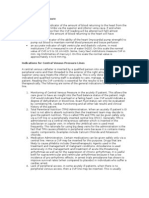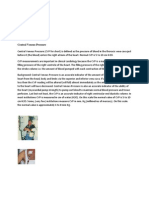PCV Vetlearn
PCV Vetlearn
Uploaded by
Jorge Pablo VillaseñorCopyright:
Available Formats
PCV Vetlearn
PCV Vetlearn
Uploaded by
Jorge Pablo VillaseñorOriginal Title
Copyright
Available Formats
Share this document
Did you find this document useful?
Is this content inappropriate?
Copyright:
Available Formats
PCV Vetlearn
PCV Vetlearn
Uploaded by
Jorge Pablo VillaseñorCopyright:
Available Formats
1CE CE Article #1
CREDIT
WEB EXCLUSIVE
Fluid Therapy: Monitoring Central
Venous Pressure
T
he key to maintaining the hydration The tip of the catheter should be cranial to the atrium (not in
Jessica Kerr, status of a patient is rigorous moni- it); taking a radiograph to confirm the location is recom-
BA, CVT, VTS (ECC)
toring. In most instances, checking mended.1,2
the intravenous fluid rate, recording the patient’s mentation and Technicians need to be particularly attentive during CVP
respiratory rate, auscultating the lung fields, and calculating monitoring because placement of the patient and the manom-
urine output are sufficient monitoring parameters. However, for eter has to be consistent (see box). Because CVP values vary, the
some patients, central venous pressure (CVP) monitoring may veterinarian may establish a baseline for each patient. Changes
be elected, particularly if the patient is prone to hypertension or in trends for individual patients are then monitored closely, and
has a history of renal, lung, or heart disease.1,2 any increase or decrease of 5 cm of water should be brought to
CVP measures the success of the interaction among cardiac the veterinarian’s attention.1 VT
pumping, circulating blood flow, vascular tone, and intratho-
racic pressures. This measurement determines how much fluid References
1. Battaglia A. Small Animal Emergency and Critical Care. Philadelphia: WB
can be administered to a patient without causing fluid overload.1
Saunders; 2001:36-55.
To obtain CVP measurements, a central line catheter is 2. Cahill M (ed). Fluids and Electrolytes Made Incredibly Easy. Springhouse, Pa.:
placed into the anterior vena cava through the jugular vein. Springhouse Corp.; 1997.
CVP Monitoring
Supplies needed
• Extension set • Tape
• Three-way stopcock • CVP manometer
• 250-ml bag of isotonic fluids • Heparinized saline flush
• 20-ml/drop intravenous line • Level, with rolled gauze tied to each end
Procedure:
• Attach the intravenous line to the bag of fluids, and run the zero mark on the manometer and pull the other end
the fluids through the line, leaving no air bubbles. parallel to the thoracic inlet of the patient.
• Attach the stopcock to the end of the fluid line. • When the level is showing accuracy, tape the manome-
• Attach the extension line to the opposite end of the ter to the side of the cage.
stopcock. • Open up the extension line.
• Attach the manometer to the upright part of the stop- • The fluid level in the manometer will equilibrate with the
cock. pressure in the vena cava.
• Fill the manometer and the extension set with the intra- • The level will fluctuate during respirations or heartbeats;
venous fluids. if there is no fluctuation, the catheter may not be in far
• Turn off the intravenous fluids. enough.
• Use heparinized saline to flush the jugular catheter. • After the level has settled, record the measurement in
centimeters (cm).
• Make sure the extension set is clamped, and then attach
it to the jugular catheter. • A minimum of three readings should be recorded.
• Place the patient in lateral recumbency, and make sure • It is important to note the position of the patient in
the zero mark of the manometer is level with the right the cage when readings are made; a change in posi-
atrium. Using a level, pull one end of the gauze strip to tion could create inaccurate readings.
VETERINARY TECHNICIAN; May 2009
©2009 Veterinary Learning Systems (VLS).
Reprinting or posting on an external website without written permission from VLS is a violation of copyright law.
You might also like
- Stephen Wolinsky - Dark Side of Inner ChildDocument193 pagesStephen Wolinsky - Dark Side of Inner Childreikiselfmaster97% (30)
- Vexus ScoreDocument28 pagesVexus Scorerev nashrulez100% (2)
- Central Venous Pressure MeasurementDocument2 pagesCentral Venous Pressure Measurementcayla mae carlos100% (3)
- Mitusha Thesis Water Analysis GGG PDFDocument50 pagesMitusha Thesis Water Analysis GGG PDFLD LD0% (2)
- Monitoring Hemodynamic StatusDocument50 pagesMonitoring Hemodynamic StatusShafiq Ur RahmanNo ratings yet
- Central Venous Pressure (CVP)Document38 pagesCentral Venous Pressure (CVP)Kimberly Abella CabreraNo ratings yet
- CVP MonitoringDocument24 pagesCVP MonitoringChoji Heiwajima100% (1)
- Essential Nursing Procedures Assignment - 092039Document14 pagesEssential Nursing Procedures Assignment - 092039IRA MONIQUE CABADENNo ratings yet
- CVP LineDocument26 pagesCVP LineÂbdàlláh Âl Ñàjjár50% (2)
- CVP Measurement and CareDocument18 pagesCVP Measurement and CareKing of The momentNo ratings yet
- 4 CVPDocument2 pages4 CVPAudrey Ann AcobNo ratings yet
- Io 8 S 9 Dfxtywgs 86 FyDocument52 pagesIo 8 S 9 Dfxtywgs 86 Fypredatorz.mecetNo ratings yet
- 2571central Venous PressureDocument39 pages2571central Venous PressurePoojaNo ratings yet
- Central Venous CatheterDocument35 pagesCentral Venous CatheterOsid HussainNo ratings yet
- Take5 Hemodynamic1Document2 pagesTake5 Hemodynamic1est03No ratings yet
- Central VenousCatheterr CareDocument57 pagesCentral VenousCatheterr Caretiger48762No ratings yet
- Central Venous PressureDocument22 pagesCentral Venous Pressurejhong100% (1)
- CVP PPPDocument13 pagesCVP PPPYep Yep100% (1)
- CVP 3rd YearDocument11 pagesCVP 3rd YearChonkayshek Rias BarrunNo ratings yet
- Central Venous PressureDocument39 pagesCentral Venous PressureJelly Rose Bajao Otayde100% (2)
- 3730 Monitoring Hemodinamik-2019Document52 pages3730 Monitoring Hemodinamik-2019ojika olandaNo ratings yet
- Nur422-Hemodynamic Monitor 1Document36 pagesNur422-Hemodynamic Monitor 1hanady alsnedNo ratings yet
- CVP and Total Parenteral NutritionDocument4 pagesCVP and Total Parenteral Nutritionkenjam89mbNo ratings yet
- Central Venous PressureDocument10 pagesCentral Venous PressureDenise EspinosaNo ratings yet
- Central Venous Pressure MeasurementDocument6 pagesCentral Venous Pressure MeasurementghalaalsolumiNo ratings yet
- CVP ReportDocument37 pagesCVP ReportJulienne Sanchez-SalazarNo ratings yet
- CVP MonitoringDocument7 pagesCVP Monitoringgurneet kourNo ratings yet
- Central Venous PressureDocument4 pagesCentral Venous Pressuremike_steven12No ratings yet
- CVPDocument23 pagesCVPShalini KaluraNo ratings yet
- Christian Ian A DialysisDocument4 pagesChristian Ian A DialysisMc LagulaNo ratings yet
- Central Venous PressureDocument5 pagesCentral Venous Pressureneen150No ratings yet
- Group3 - Sunico, Valenzuna, VelezDocument15 pagesGroup3 - Sunico, Valenzuna, VelezMichelle SunicoNo ratings yet
- CVPDocument33 pagesCVPbharti PatelNo ratings yet
- kh7 CVPDocument50 pageskh7 CVPأبوأحمد الحكيمNo ratings yet
- Sub - Medical Surgical Nursing: Assignment On CVP MonitoringDocument11 pagesSub - Medical Surgical Nursing: Assignment On CVP Monitoringkamini ChoudharyNo ratings yet
- Cerebrospinal Fluid Drainage/External Ventricular Drain (EVD)Document4 pagesCerebrospinal Fluid Drainage/External Ventricular Drain (EVD)Jericho ThomasNo ratings yet
- Hemodynamic Monitoring of The Critical PatientDocument58 pagesHemodynamic Monitoring of The Critical PatientScribdTranslationsNo ratings yet
- Measurement of CENTRAL VENOUS PRESSURE Via A TransducerDocument22 pagesMeasurement of CENTRAL VENOUS PRESSURE Via A TransducerJasleen KaurNo ratings yet
- CVP MonitoringDocument16 pagesCVP MonitoringVictor Elvis0% (1)
- Central Venous PreasureDocument22 pagesCentral Venous PreasureD ZamiatNo ratings yet
- Measuring Central Venous Pressure FinalDocument6 pagesMeasuring Central Venous Pressure FinalPatel HimaniNo ratings yet
- External Ventricular Drainage: Prepared By: Aseem Aljanabi Pediatric Clinical InstructorDocument34 pagesExternal Ventricular Drainage: Prepared By: Aseem Aljanabi Pediatric Clinical Instructoraseem100% (1)
- Central Venous Preasure: By: Engkus Kusnadi, S.Kep., M.KesDocument22 pagesCentral Venous Preasure: By: Engkus Kusnadi, S.Kep., M.KesNenazNaziahNo ratings yet
- Hemodynamicmonitorig 160407141401Document96 pagesHemodynamicmonitorig 160407141401abeer alzhoorNo ratings yet
- HemodynamicsDocument5 pagesHemodynamicsGeraldine TeneclanNo ratings yet
- CVP Final 2021Document11 pagesCVP Final 2021Ahmed AshrafNo ratings yet
- Pulmonary Artery Catheterization and MonitoringDocument31 pagesPulmonary Artery Catheterization and MonitoringVhince Norben PiscoNo ratings yet
- Patient Monitoring in ICUDocument5 pagesPatient Monitoring in ICUamirmohammadxtx4No ratings yet
- Central Venous PressureDocument46 pagesCentral Venous Pressureeman.sasaNo ratings yet
- Reviewer 418Document15 pagesReviewer 418Denese JocsonNo ratings yet
- CC, CVP MonitoringDocument5 pagesCC, CVP MonitoringM7md Al-HuwaitiNo ratings yet
- Central Venous Monitoring 2022Document17 pagesCentral Venous Monitoring 2022AngieNo ratings yet
- Hemodynamic MonitoringDocument4 pagesHemodynamic Monitoringgurneet kourNo ratings yet
- Review On Peripheral IV FluidsDocument37 pagesReview On Peripheral IV FluidsWoot RootNo ratings yet
- Haemodynamic MonitoringDocument30 pagesHaemodynamic MonitoringMaiiaNo ratings yet
- Central Venous PressureDocument8 pagesCentral Venous PressureJen GarzoNo ratings yet
- Haemodynamicmonitoring 180208210620Document30 pagesHaemodynamicmonitoring 180208210620Morad KananNo ratings yet
- Central Lines AND Arterial LinesDocument30 pagesCentral Lines AND Arterial LinesamiraattyaNo ratings yet
- Measuring Central Venous Pressure: Elaine ColeDocument8 pagesMeasuring Central Venous Pressure: Elaine ColednllkzaNo ratings yet
- Cardiac Surgical Operative AtlasFrom EverandCardiac Surgical Operative AtlasThorsten WahlersNo ratings yet
- Course Outline For NCMDocument25 pagesCourse Outline For NCMIanne Sandra Sorrosa100% (1)
- The Aksys Personal Hemodialysis SystemDocument3 pagesThe Aksys Personal Hemodialysis SystemNatik Bi IllahNo ratings yet
- Pneumonia Case StudyDocument33 pagesPneumonia Case StudyArceo AbiGail100% (3)
- All BFM 2002Document12 pagesAll BFM 2002HEMATOLOGYCARE DR SK GUPTANo ratings yet
- Mental Health QuestionnaireDocument1 pageMental Health QuestionnaireIceMaster Minato67% (3)
- WaterleafDocument2 pagesWaterleafGILBERTNo ratings yet
- Chapter 7Document134 pagesChapter 7raguchandra7527No ratings yet
- Stock Jobal Pharma (Precio) - Productos Marca Propia 02.07.24Document2 pagesStock Jobal Pharma (Precio) - Productos Marca Propia 02.07.24angelyrufinoNo ratings yet
- MSD - SparshDocument10 pagesMSD - SparshGiridhar GaneshNo ratings yet
- Saldo Penerimaan & Pengeluaran07 - Maret - 2021Document34 pagesSaldo Penerimaan & Pengeluaran07 - Maret - 2021Desi Yuliana HarahapNo ratings yet
- Prefinal ProgramDocument1 pagePrefinal ProgramHussein AhmedNo ratings yet
- Weldon Owen 2015 CatalogDocument97 pagesWeldon Owen 2015 CatalogWeldon Owen PublishingNo ratings yet
- Effect of Glycine Powder Air Polishing On The Gingiva PetersDocument9 pagesEffect of Glycine Powder Air Polishing On The Gingiva PetersJeremy VoNo ratings yet
- Alcohol Use DisorderMay2021Document49 pagesAlcohol Use DisorderMay2021Kreshnik IdrizajNo ratings yet
- Nursing Care Plan Cues Nursing Diagnosis Analysis Goal Intervention Rationale Evaluatio NDocument3 pagesNursing Care Plan Cues Nursing Diagnosis Analysis Goal Intervention Rationale Evaluatio NAishleen OrmandoNo ratings yet
- Products MedrixDocument2 pagesProducts MedrixAmit KumarNo ratings yet
- NCP For Case StudyDocument10 pagesNCP For Case StudySarah BenjaminNo ratings yet
- Basic PsychoPharma MnemonicsDocument21 pagesBasic PsychoPharma MnemonicsJoseph Rommel Castro CortezNo ratings yet
- Asbestos - OverviewDocument4 pagesAsbestos - Overviewapi-328418463No ratings yet
- WM ALS Quarter 1 Module 1Document7 pagesWM ALS Quarter 1 Module 1RUTH MAE GULENGNo ratings yet
- Hepatic EncelopathyDocument10 pagesHepatic EncelopathyWinny WullurNo ratings yet
- Guia de Manejo Sdra 2019Document27 pagesGuia de Manejo Sdra 2019Jorge VidalNo ratings yet
- Recent Concepts in Minimal Access Surgery: Deborshi Sharma Priya HazrahDocument492 pagesRecent Concepts in Minimal Access Surgery: Deborshi Sharma Priya HazrahlakshitNo ratings yet
- What Is A Care Pathway 5 Examples & Management SolutionsDocument1 pageWhat Is A Care Pathway 5 Examples & Management SolutionsfloagbayanibautistaNo ratings yet
- Research Reports in Oral and Maxillofacial Surgery Rroms 5 055Document10 pagesResearch Reports in Oral and Maxillofacial Surgery Rroms 5 055aguunggpNo ratings yet
- Agenda - Addressing Mental Health - World Health Organization (WHO)Document17 pagesAgenda - Addressing Mental Health - World Health Organization (WHO)jenniferNo ratings yet
- TriageDocument27 pagesTriageDanette Mae RocNo ratings yet
- IMCI - For PakistanDocument35 pagesIMCI - For Pakistanerajkhan100% (1)

























































































